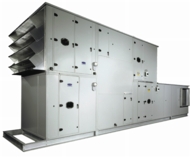AHUs as the heart of an efficient air-conditioning system

As movers of large quantities of air, air-handling units are responsible for a high proportion of a system’s energy use — so their specification merits close attention to detail and the conditions under which they operate.
• Fan motors
• Heat-recovery systems such as thermal wheels
• Coils
• Unit construction
• Filters To produce an efficient unit, it is important for a manufacturer to have a demonstrably effective process for managing the supply chain, to use efficient fans, to incorporate an efficient heat exchanger and to use a form of construction that minimises air leakage and meets at least L2 (Class B) and not merely stating any figure ‘as defined’ in BS EN 1886. Air filters Although today most major manufacturers use similar air filters, they have become a major factor in describing system efficiency Carrier, for example, has traditionally used a mid-point state for its calculations (or dirty if specified) when selecting its AHUs — an approach which would normally be regarded as good practice and also correct and appropriate when calculating energy consumption. However, according to the current version of Part L guidelines this would not be correct for calculating SFP. Part L says that SFP values should be calculated following prEN13 779 (2005) [Draft]. This states that the design air volume used in the calculation should be ‘under clean-load conditions’. This is still the case in the most recent issues too — a clear contradiction. Inverters To complicate matters further, where inverters are fitted, which nowadays is in most cases, their efficiency should also be taken into account and the SFP requirement should be judged as being met only with the inverter effect included, because its energy impact is significant. As an example, a 7.5 kW inverter would actually increase the initial fan calculated SFP by around 5%. This effect obviously raises interesting questions and probably will require most manufacturers to modify their selection software — certainly as far as providing SFP data is concerned, otherwise it will not be easy for like-for-like system comparisons between different manufacturers to be carried out. At the end of the day, manufacturing for energy efficiency should be truly about optimising selections and the use of the most energy-efficient components overall in the long term. A further detail on filters is that clean filters become dirty quite quickly, which can rapidly change the operating characteristics of an AHU. A mid-point calculation really is more representative of an operating system and certainly the figures are quite telling — a system that appeared to be energy efficient at this point would be energy efficient indeed. This fact also raises interesting operational considerations when a system’s energy use is measured and logged during operation. A system that was chosen on the basis of clean-load calculations would find it difficult to achieve/measure those energy-use figures. However, as previously mentioned, this is actually covered by the fact that ‘energy-consumption’ figures are indeed supposed to be calculated using a mid-point condition. Yet another set of calculations to compute! Although the emphasis of this discussion and these calculations appear to be very focused on the AHU manufacturer, everyone involved in the airside package needs to play their part — not least the building-services consultant. External static pressure For example, the initial estimation of external static pressures (ductwork and terminals) early in a project, now has to be taken far more seriously. Nominal assumptions (typically, say 600 Pa!) can put extreme pressure on the AHU manufacturer, which can sometimes be put in the position of either not being able to comply with Part L or ending up with unit dimensions so oversized they do not fit into the plantroom space available! Enabling building occupiers to comply with society’s energy commitment, both today and in the future requires more than meeting broadbrush requirements. Detailed project-specific specifications must be written. Also the exact performance requirements for a unit must be set out in detail — for example Class L2 (B) rather than just Class L3 and more specifically T2, TB2, rather than the more general statement ‘as in accordance with BS EN 1886’. The specifications and performance requirements must make absolute sense in the context of the system as a whole if air-handling is to be supplied that is truly the heart of an energy-efficient air-conditioning system. I am sure we all accept the need to play our part in reducing carbon emissions, but I would just ask if we are selecting equipment purely to meet a given figure or for long-term energy efficiency. Tony Millard is Carrier UK sales director for air-handling units.







